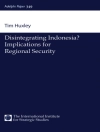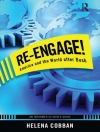The SAGE Handbook of the History, Philosophy and Sociology of International Relations offers a panoramic overview of the broad field of International Relations by integrating three distinct but interrelated foci. It retraces the historical development of International Relations (IR) as a professional field of study, explores the philosophical foundations of IR, and interrogates the sociological mechanisms through which scholarship is produced and the field is structured.
Comprising 38 chapters from both established scholars and an emerging generation of innovative meta-theorists and theoretically driven empiricists, the handbook fosters discussion of the field from the inside out, forcing us to come to grips with the widely held perception that IR is experiencing an existential crisis quite unlike anything else in its hundred-year history. This timely and innovative reference volume reflects on situated scholarly practices in a way that projects our collective thinking into the future.
PART ONE: THE INWARD GAZE: INTRODUCTORY REFLECTIONS
PART TWO: IMAGINING THE INTERNATIONAL, ACKNOWLEDGING THE GLOBAL
PART THREE: THE SEARCH FOR (AN) IDENTITY
PART FOUR: INTERNATIONAL RELATIONS AS A PROFESSION
PART FIVE: LOOKING AHEAD: THE FUTURE OF META-ANALYSIS
Spis treści
Part 01: The Inward Gaze: Introductory Reflections
Chapter 1: The struggle for the soul of International Relations: Fragments of a collective journey – Andreas Gofas, Inanna Hamati-Ataya, and Nicholas Onuf
Chapter 2: Crafting the reflexive gaze: Knowledge of knowledge in the social worlds of International Relations – Inanna Hamati-Ataya
Part 02: Imagining the International, Acknowledging the Global
Chapter 3: From the international to the global? – Jens Bartelson
Chapter 4: Coloring the global: Race, colonialism and internationalism – Himadepp Muppidi
Chapter 5: Liberal International Political Economy as colonial science – David L. Blaney and Naeem Inayatullah
Chapter 6: International Relations as a historical social science – George Lawson
Chapter 7: International Relations and the gendered international – Jacqui True and Sarah Hewitt
Chapter 8: Beyond the ′religious turn′: International Relations as political theology – Mustapha Kamal Pasha
Chapter 9: Between ′East′ and ′West′: Travelling theories, travelling imaginations – Zeynep Gülsah Çapan and Ayse Zarakol
Chapter 10: International Relations and the rise of Asia : A new ′moral imagination′ for world politics? – L.H.M. Ling and Boyu Chen
Chapter 11: Confucian pacifism or Confucian confusion? – Victoria Tin-bor Hui
Chapter 12: The challenges of ′contextualism′ – Evgeny Roshchin
Chapter 13: Imagining International Relations through alternative worlds – Richard Ned Lebow
Part 03: The Search for (an) Identity
Chapter 14: The origins of International Relations: Idealists, administrators and the institutionalization of a new science – Torbjørn L. Knutsen
Chapter 15: Canon fodder: The founding fathers, classics, and ′isms′ of International Relations – Jeremy Youde and Brent J. Steele
Chapter 16: The function of myths in International Relations: Discipline and identity – Halvard Leira and Benjamin de Carvalho
Chapter 17: Identity and theory: Towards sociological explanations of ′schools′ in International Relations – Peter Marcus Kristensen and Yongjin Zhang
Chapter 18: International Relations′ crystal ball: Prediction and forecasting – Patrick James and Randall J. Jones Jr.
Chapter 19: The problem of social utility International Relations and the ′policy gap′ – Nicholas Michelsen
Chapter 20: A fear of foundations? – Colin Wight
Chapter 21: After first principles: The sociological turn in International Relations as disciplinary crisis – Daniel J. Levine and Alexander D. Barder
Chapter 22: International Relations and the challenges of interdisciplinarity – Tanja Aalberts
Chapter 23: ′Does it matter if it′s a discipline?′ bawled the child – Patrick Thaddeus Jackson
Part 04: International Relations as a Profession
Chapter 24: The unequal profession – Arlene B. Tickner
Chapter 25: From community to practice: International Relations as a practical configuration – Christian Bueger and Frank Gadinger
Chapter 26: Rule by referees? The curious world of academic judgment – Thomas Volgy
Chapter 27: International Relations expertise at the interstices of fields and assemblages – Anna Leander
Chapter 28: International Relations ideas as reflections and weapons of US foreign policy – Ido Oren
Chapter 29: For as undisciplined take on International Relations: The politics of situated scholarship – David Grondin and Anne-Marie D′Aoust
Chapter 30: Counter-mapping the discipline: The archipelagos of Western International Relations teaching – Jonas Hagmann and Thomas Biersteker
Chapter 31: E Pluribus Unum? How textbooks cover theories – Felix Berenskoetter
Chapter 32: International pedagogical relations in fragments: Politics and poetics in the classroom and beyond – Erzsébet Strausz
Chapter 33: Training in critical interpretivism, within and beyond the academy – Marcos Scauso, Tanya B. Schwarz and Cecelia Lynch
Chapter 34: The dialectic of politics and science from a post-truth standpoint: An outsider′s perspective on the field of International Relations – Steve Fuller
Chapter 35: What we do: International Relations as craft – Nicholas Onuf
Part 05: Looking Ahead: The Future of Meta-Analysis
Chapter 36: A historiographer′s view: Rewriting the history of international thought – Lucian M. Ashworth
Chapter 37: Meta-analysis: A philosophical view – John G. Gunnell
Chapter 38: A sociologist′s view: Keeping it worldly – Ole Wæver
O autorze
Dr. Hamati-Ataya′s research lies at the intersection(s) of world politics, global history, social theory, natural and historical epistemology, and the anthropology, history, and sociology of culture, knowledge, science, and technology. She is since 2013 a Marie Curie fellow under the European Commission′s 7th Framework Programme, and has recently been awarded a European Research Council Consolidator Grant under the EU′s Horizon 2020 Research and Innovation programme for her project ARTEFACT beginning in 2017.












